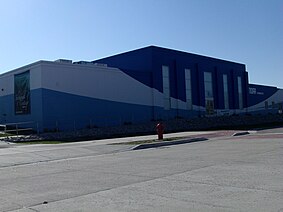Thunder Bay National Marine Sanctuary
| Thunder Bay National Marine Sanctuary and Underwater Preserve | |
|---|---|
 Great Lakes Maritime Heritage Center | |
Location among Michigan's Underwater Preserves | |
| Location | Lake Huron (Alcona, Alpena, and Presque Isle counties, Michigan) |
| Nearest city | Alpena, Michigan |
| Coordinates | 45°00′12″N 83°15′11″W / 45.0034°N 83.253°W |
| Area | 4,300 sq mi (11,000 km2) |
| Established | June 22, 2000 |
| Governing body | Michigan Department of Natural Resources, National Oceanic and Atmospheric Administration |
Thunder Bay National Marine Sanctuary and Underwater Preserve is a United States National Marine Sanctuary on Lake Huron's Thunder Bay, within the northeastern region of the U.S. state of Michigan. It protects an estimated 116 historically significant shipwrecks ranging from nineteenth-century wooden side-wheeler paddle steamers to twentieth-century steel-hulled steamers. There are a great many wrecks in the sanctuary, and their preservation and protection is a concern for United States Government policymakers.[1] The landward boundary of the sanctuary extends from the western boundary of Presque Isle County to the southern boundary of Alcona County. The sanctuary extends east from the lakeshore to the international border. Alpena is the largest city in the area.
History
[edit]
The National Oceanic and Atmospheric Administration established Thunder Bay National Marine Sanctuary and Underwater Preserve on June 22, 2000.[2] It became the thirteenth national marine sanctuary overall and first on the Great Lakes. Original boundaries followed that of Alpena County to 83 degrees west longitude totaling 448 square miles (338 sq nmi; 1,160 km2). In 2014 it was expanded to 4,300 square miles (11,137 km2).[3] The marine sanctuary contains many shipwrecks, such as the hull of package freighter SS Pewabic.
Great Lakes Maritime Heritage Center
[edit]

Tied to the sanctuary is the Great Lakes Maritime Heritage Center. The museum, located in Alpena on the Thunder Bay River, features exhibits about local shipwrecks and the Great Lakes, an auditorium, an archaeological conservation laboratory, and education areas.
Visitation
[edit]Thunder Bay National Marine Sanctuary offers a variety of recreational activities for visitors. The sanctuary is renowned for its exceptional shipwreck diving experiences, suitable for both novice and experienced divers. Several charter services provide guided dives to the sanctuary's shipwrecks, ensuring safe and educational experiences. Boating is another popular activity, with numerous boat launches and marinas available in the area.[4]
See also
[edit]- List of shipwrecks in the Thunder Bay National Marine Sanctuary
- Michigan Underwater Preserves
- Rockport State Park
References
[edit]- ^ Statement of Thunder Bay National Marine Sanctuary Director Archived 2007-07-15 at the Wayback Machine
- ^ "Sanctuary Designations & Expansions". NOAA. Retrieved October 17, 2024.
- ^ Smith, Vernon; Gandualla, Stephanie. "NOAA expands Thunder Bay National Marine Sanctuary in Lake Huron". NOAA. Retrieved 11 September 2014.
- ^ "Thunder Bay National Marine Sanctuary: Exploring America's Underwater Treasures". www.greatlakesdirect.com. Retrieved 2024-06-13.
External links
[edit]- Thunder Bay National Marine Sanctuary and Underwater Preserve NOAA
- Great Lakes Maritime Heritage Center NOAA
- Michigan Underwater Preserve Council
- "In Michigan, a Park Made of Water" – New York Times
- Archaeological sites in Michigan
- Landmarks in Michigan
- Marine parks of Michigan
- Maritime museums in Michigan
- Museums in Alpena County, Michigan
- National Marine Sanctuaries of the United States
- Protected areas of Alpena County, Michigan
- Protected areas established in 2000
- 2000 establishments in Michigan
- Thunder Bay National Marine Sanctuary
- Lower Peninsula, Michigan geography stubs
- Midwestern United States museum stubs
- Michigan building and structure stubs

